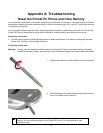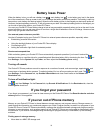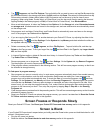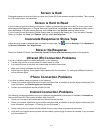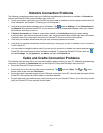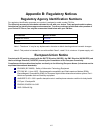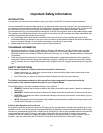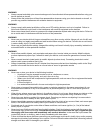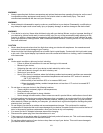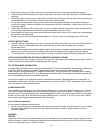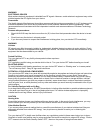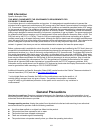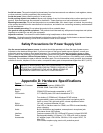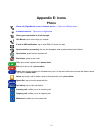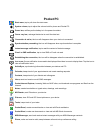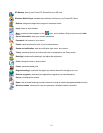Never paint or apply any foreign substance to this device as this can clog and damage moving parts.
Clean terminals (metallic parts) on a regular basis with a dry cotton swab. Dirty terminals could affect battery
charging.
Never use organic solvents such as benzene or paint thinner to clean your device. Use of these solvents can
cause deformation or discoloration. Wipe dirty parts with a soft dry cloth.
Do not wipe the display with a damp or wet cloth or touch the display with damp or wet hands. Wiping or
touching the display under this condition can cause product failure or malfunction. Always use a soft dry cloth
to wipe the display.
When using the optional “SD memory card”, be sure to read the relevant instruction manual and ensure that
you know the proper procedures for their use and compatibility with your device.
Never subject the card to any severe shock while connected to your device. Such a shock can cause damage
to the card and a malfunction.
Do not carry your device with the card connected to it. This can result in the damage or loss of the card.
SAFETY INSTRUCTIONS
When the device is operating, do not insert or remove the “SD memory card” into or out of the SD card slot or
connect or disconnect the device from the cradle as this may cause loss of stored data, or product
failure/malfunction.
Never connect cradle terminals with metallic objects, such as wires. Connecting these terminals with metallic
objects may cause the production of excess heat, burns and damage to the charger and/or your device.
To avoid eye strain, take frequent visual breaks, focusing on objects located at a distance greater than 15 feet.
SAFE USE AND OPERATION OF DEVICE (WIRELESS HANDHELD PHONE)
Read this information before using your device. Your device is a low power radio transmitter and receiver. When it
is ON, it receives and also sends out radiofrequency (RF) signals.
FCC RF EXPOSURE INFORMATION
In August 1996, the Federal Communications Commission (FCC) of the United States, with its action in Report and
Order FCC 96-326, adopted an updated safety standard for human exposure to radiofrequency (RF)
electromagnetic energy emitted by FCC regulated transmitters. Those guidelines are consistent with the safety
standard previously set by both U.S. and international standards bodies. The design of this device complies with
the FCC guidelines and these international standards.
Use only the supplied or an approved antenna. Unauthorized antennas, damaged antennas, modifications, or
attachments could impair call quality, damage the phone, or result in violation of FCC regulations. Please contact
your local dealer for replacement antenna.
PHONE OPERATION
When speaking into the Microphone or the Earphone Microphone, a minimum separation distance of 1 inch (2.5
cm) must be maintained between the user's face and the device, including its antenna, to comply with the FCC
exposure limits. This particular device has not been designed for held-to-ear use and should never be used against
the ear. In front of your face, hold the device keeping distance from your body. or, In front of your face, hold the
device wearing the earpiece keeping distance from your body.
Tips on Efficient Operation:
For your phone to operate most efficiently:
Do not touch the antenna unnecessarily and keep the antenna from metal when the phone is in use. Contact
with the antenna affects call quality and may cause the phone to operate at a higher power level than
otherwise needed.
WARNING
DRIVING
Never use a device and/or cell phone while driving an automobile or any other moving vehicle. Always pull out of
traffic and come to a stop in a legally permissible and safe location before using your device. Failure to do so could
result in serious bodily injury in a traffic accident.
107



